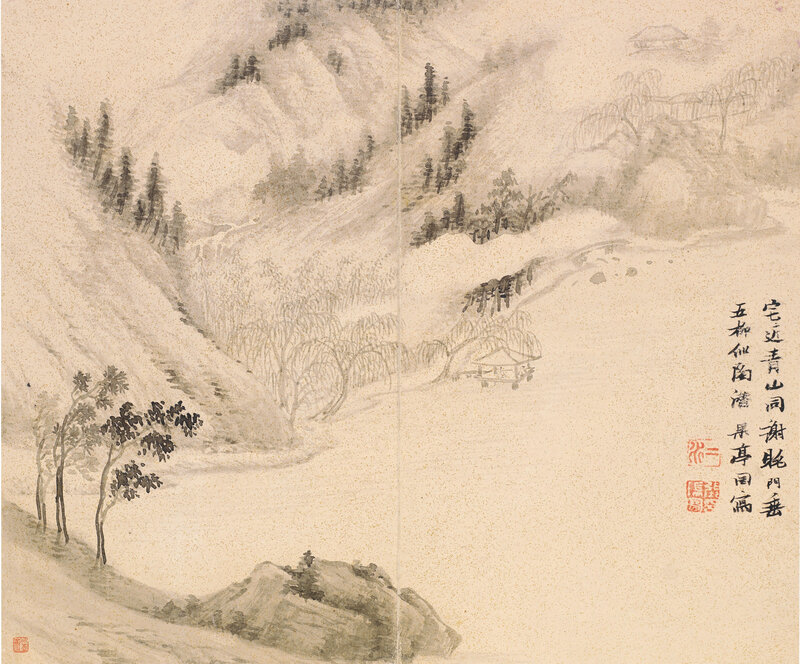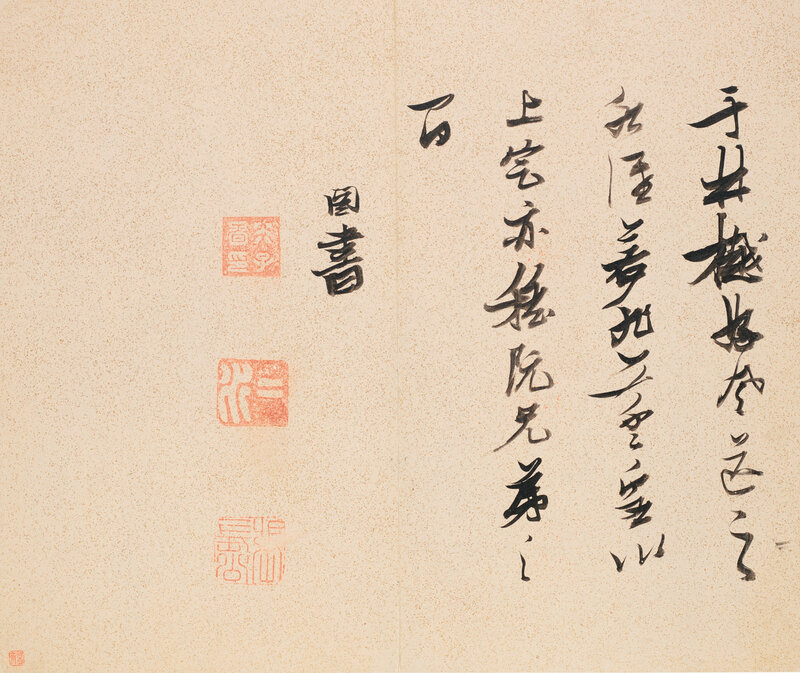Zhang Ruitu (Attributed to, 1570-1641), Landscapes and Calligraphy
Lot 811. Zhang Ruitu (Attributed to, 1570-1641), Landscapes and Calligraphy. Estimate USD 100,000 - USD 150,000. Price realised USD 3,210,000. © Christie's Images Ltd 2020.
Album of fourteen double leaves, ink on gold-flecked paper. Each leaf measures 11 ½ x 13 5/8 in. (29.2 x 34.8 cm.). Each leaf inscribed and signed, with a total of twenty-six seals of the artist. Dated yichou year of the Tianqi reign (1625). Dedicated to Zhu Wan (active 1573-1620). Frontispiece inscribed and signed by Naito Konan (1866-1934), with three seals. Colophon by Nagao Uzan (1864-1942), with two seals. Titleslips by Nagao Uzan and Naito Konan, with two seals each. Eighteen collector’s seals
Provenance: Mayuyama & Co., Japan.
Ambassador Jean Daridan (1906-2002) Collection, France, until 1970.
Purchased from J.C. Moreau-Gobard, Paris, 10 September 1970;
The James and Marilynn Alsdorf Collection, Chicago.
Literature: Sekai Bijutsu Zenshu, vol. 20, Heibonsha, Tokyo, 1953, p. 259, pls. 26-27 (illustrated, two leaves).
Yoshiho Yonezawa, Painting in the Ming Dynasty, Mayuyama & Co., Tokyo, 1956, pl. 20 (illustrated, one leaf).
Osvald Siren, Chinese Paintings, Leading Masters and Principles, London, 1956, vol. 7, p. 155.
The Arts Club of Chicago, Chinese Art from the Collection of James W. and Marilynn Alsdorf, Chicago, 1970, no. P5.
Mayuyama & Co., Ltd, Mayuyama, Seventy Years, Volume Two, Tokyo, 1976, no. 178, p. 89 (illustrated, one leaf).
Exhibited: Chicago, The Arts Club of Chicago, Chinese Art from the Collection of James W. and Marilynn Alsdorf, 21 September-13 November 1970.
Note: The calligrapher and painter Zhang Ruitu truly embodied all the qualities of a traditional Chinese literati artist. He was academically accomplished and placed third in the imperial civil service examination held during the thirty-fifth year of the Wanli reign (1607) and so was awarded the title of tanhua. He held various high government posts until he suffered an ignominious forced-retirement after he was implicated in the corruption charges against the once-powerful eunuch Wei Zhongxian (1568-1627).
The recipient of this album by Zhang Ruitu was a literatus named Zhu Wan, whose sobriquet was Jimei and style name Baiyue. According to Shushi huiyao, he was a distinguished calligrapher of clerical script and was active during the Wanli reign (1573-1620). He was also well-regarded for his fine cursive and standard script, which he modeled after Yan Zhenqing (709-985). While we do not know Zhang Ruitu’s relationship with Zhu Wan, nor do we know the circumstance under which the album was created or commissioned, it is possible if unusual for a work of art to be dedicated to a recipient who has passed away in memoriam. Of the eleven poems written in this album, only one is an original by Zhang Ruitu. The authors of the texts in sequential order are: Li Bai (701-762), Gao Lian (1573-1620), Zhang Ruitu, Chen Jiru (1558-1639), Lu Lun (739-799), Tao Qian (Yuanming, 365-427), Tao Hongjing (456-536), Zhang Hu (Ca. 785-849), Liu Zongyuan (773-819), Jiao Dao (779-843) and Su Shi (1037-1101).
There are six double-leaf paintings in the album, five of which are accompanied by poetic couplets. It is reasonable to assume that Zhang Ruitu’s creative process began with selecting the desired poems, and then illustrating them. The opening vignette serves as a fine example: Zhang Ruitu inscribed Li Bai’s verses: “A house near the Blue Mountain similar to that of Xie Tiao; willow branches drape over the door like those of Tao Yuanming.” The Blue Mountain is located southeast of Dangtu county in Anhui province. Xie Tiao (464-499) was a literatus of the Qi Kingdom of the Southern Dynasty and once held the governorship of Xuan city. While he was there, he built a house in the southern part of the Blue Mountain. Five willow trees near the front door refers to the reclusive residence of Tao Qian, who had five willows planted next to his house. Deep in the pictorial space, Zhang Ruitu situated a residential compound in the background mountains, where willow tress—disproportionally oversized for emphasis—are prominently featured near the front entrance. The same iconography of willows is repeated in the middle ground, with one willow arching over and framing a lakeside pavilion where two figures have gathered.
Echoing the landscape imagery in the album, the stand-alone poems without illustrations also share the same recurring theme—they are mostly narratives that describe the observations of nature's sights and sounds, from the perspectives of hermit mountain dwellers and visitors to solitary temples in the mountains. The longing for nature, tranquility, and simplicity, away from politics, worldly entanglements, and artificial ornaments, is clearly reflected through both the text selection and pictorial interpretations. While themes like this—a perennial favorite among the traditional literati—could easily appear to be a trope, nuances articulated by Zhang Ruitu have transformed the scene into a refreshing presentation of a literati ideal.
Throughout the album, Zhang Ruitu, one of the most highly regarded calligraphers of the Ming dynasty, wrote with his signature style: angular, geometric, energetic, and keeping the size of the characters uniform. His paintings hark back to the literati tradition of the Song and Yuan dynasties, where the ink monotone delineations of the mountains and streams emphasize evocation of nature rather than verisimilitude. This album is accompanied by a titleslip written by Naito Tora (1866-1934). Better known as Naito Konan, he was a renowned historian and sinologist whose research and publications became very influential culturally as well as politically. He was a co-founder of the Kyoto School of historiography. The concluding pages bear a colophon by Nagao Uzan (1864-1942), an accomplished sinologist, calligrapher, painter, collector, and seal carver. In the early twentieth century, he worked in the Commercial Press in Shanghai, where he participated in the editing of textbooks for elementary schools in China. As a result of his decade in China and rich collection of Chinese paintings and calligraphy, Nagao Uzan was proud of his expertise in Chinese culture..
Christie's. Sacred and Imperial: The James and Marilynn Alsdorf Collection Part I, New York, 24 September 2020

/https%3A%2F%2Fprofilepics.canalblog.com%2Fprofilepics%2F1%2F0%2F100183.jpg)
/https%3A%2F%2Fstorage.canalblog.com%2F03%2F02%2F119589%2F96711876_o.jpg)
/https%3A%2F%2Fstorage.canalblog.com%2F11%2F31%2F119589%2F94773502_o.jpg)
/https%3A%2F%2Fstorage.canalblog.com%2F20%2F83%2F119589%2F94772815_o.jpg)
/https%3A%2F%2Fstorage.canalblog.com%2F26%2F72%2F119589%2F75604929_o.jpg)
/https%3A%2F%2Fstorage.canalblog.com%2F59%2F60%2F119589%2F26458628_o.jpg)



















/image%2F1371349%2F20240425%2Fob_c453b7_439605604-1657274835042529-47869416345.jpg)
/image%2F1371349%2F20240425%2Fob_59c6f0_440358655-1657722021664477-71089985267.jpg)
/image%2F1371349%2F20240425%2Fob_07a28e_440353390-1657720444997968-29046181244.jpg)
/image%2F1371349%2F20240425%2Fob_0b83fb_440387817-1657715464998466-20094023921.jpg)